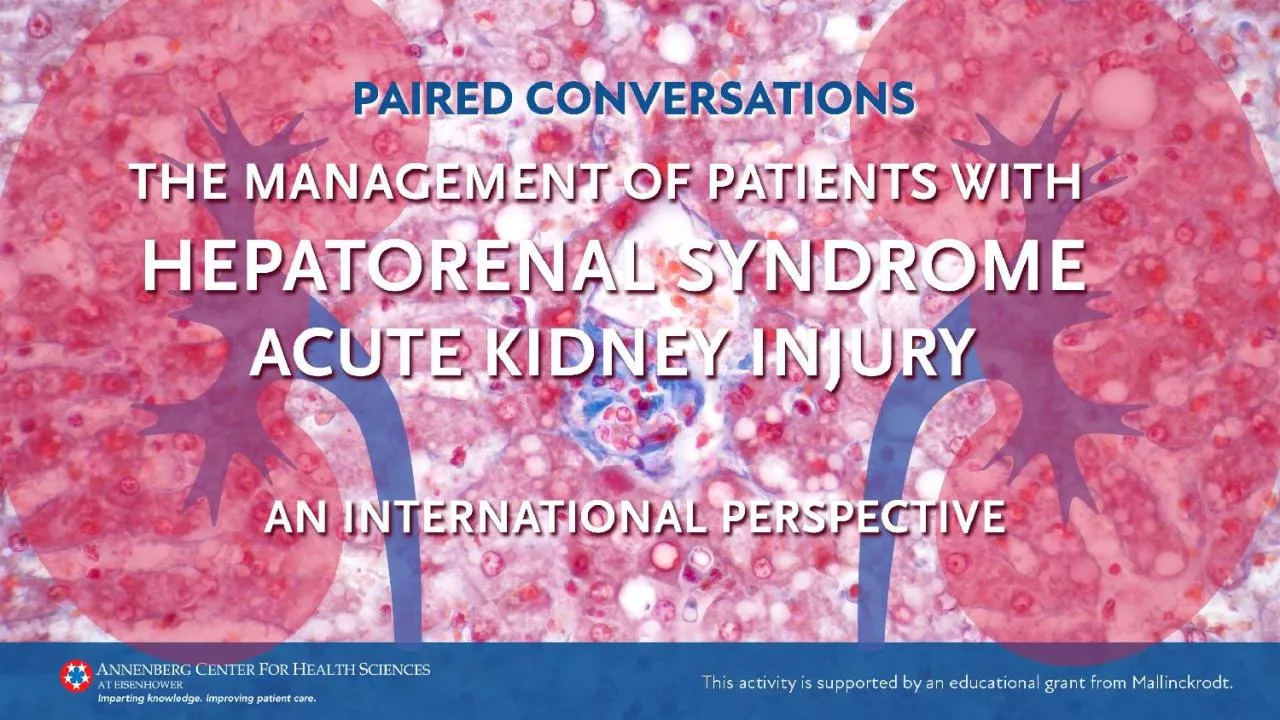

Amanda Chaney DNP APRN Mayo Clinic Florida US Kevin Moore MD University College UK Mitra Nadim MD University of Southern California California US Rahul Nanchal MD Medical College of Wisconsin Wisconsin US ID: 1037916
Download Presentation The PPT/PDF document "Faculty Paolo Angeli, MD; University of ..." is the property of its rightful owner. Permission is granted to download and print the materials on this web site for personal, non-commercial use only, and to display it on your personal computer provided you do not modify the materials and that you retain all copyright notices contained in the materials. By downloading content from our website, you accept the terms of this agreement.
1.
2. FacultyPaolo Angeli, MD; University of Padova (Italy)Amanda Chaney, DNP, APRN; Mayo Clinic (Florida, US)Kevin Moore, MD; University College (UK)Mitra Nadim, MD; University of Southern California (California, US)Rahul Nanchal, MD; Medical College of Wisconsin (Wisconsin, US)Ram Subramanian, MD; Emory University (Georgia, US)
3. CasePresenting symptoms54-yo woman admitted to hospital with hepatic encephalopathy.She experienced diarrhea x 3 d.In the ED, a CT scan of the head was normal with no evidence of intracerebral hemorrhage or ischemia.Past medical history7 y ago: infiltrating ductal carcinoma of right breast.4 y ago: decompensated liver cirrhosis with primary sclerosing cholangitis.Grade 2 ascites controlled with Na+ restriction, diuretics2 episodes of hepatic encephalopathyEndoscopy: large F2 esophageal varicesAbdominal ultrasound: no evidence of hepatocellular carcinoma, portal vein thrombosis.
4. Case (cont)Current medicationsSpironolactone 300 mg QDFurosemide 25 mg BIDPropranolol 20 mg BIDUrsodeoxycholic acid 300 mg TIDRifaximin 200 mg TIDExemestane 25 mg QIDPhysical examVital signsBP 120/50 mmHgHR 60 beats/minSpO2 99% in AARR 20 breaths/minT 36.8C.SkinJaundice, dehydration.CNSAwake, oriented in time & space, flapping tremor.AbdomenPainless ascites w/superficial collateral vessels easily visible.
5. Case (cont)WBC4.03 x 109/LC-reactive protein8 mg/LHemoglobin88 g/LAmmonia157 mol/LPlatelets89 x 109/LPMN on ascites64 el/LBilirubin4.8 mg/dLUrineNADINR1.8 (PT 20 s)Chest x-rayNLAlbumin29 g/LCreatinine1 mg/dLSodium132 mEq/LPotassium3.1 mEq/L
6. Pathogenesis and Clinical Features
7. Recognizing HRS-AKIThe definition of HRS-AKI has evolved over time, but is largely a clinical diagnosis incorporating:Patient status Serum creatinine (timing)Absence of parenchymal damage (proteinuria)Exclusion of other causes.Current definitions of HRS-AKI are limited by de-emphasizing urine output as a distinguishing variable of AKI.
8. Prevention StrategiesMaintain adequate blood pressure to preserve renal perfusionAvoid iatrogenic causes of kidney injuryAvoid dehydration
9. Pharmacological TreatmentsAlbuminNorepinephrineORORFactors influencing vasoconstrictor choiceVenous accessPatient geographyPersonnel expertise TerlipressinMidodrine + octreotide
10. Summary of CONFIRM TrialTerlipressin (n=199)Placebo (n=101)P valueVerified reversal of HRS63 (32%)17 (17%)0.006HRS reversal with no RRT at 30 days68 (34%)17 (17%)0.001Respiratory failure14%5%―Inclusion Hepatorenal syndrome, cirrhosis, ascites, and rapidly progressing renal failureDoubling of serum creatinine to at least 2.25 mg/dL (199 μmol/L)EfficacyReversal of HRS (two SCr ≤ 1.5 mg/dL) up to 14 days and survival without RRTFailure Receipt of the following:RRT, TIPS placement, open-label vasopressor therapy before day 14Wong F, et al. N Engl J Med. 2021;384(9): 818-828.
11. Vasoconstrictor Treatments↓Portal blood flowVasoconstriction↑ End-organ perfusion↓ Splanchnic blood flow↑ Renal perfusionFactors influencing vasoconstrictor choiceVenous accessPatient geographyPersonnel expertise
12. Late-Stage Therapy ApproachesFor patients not responding to initial therapies, treatment strategies vary around the worldRenal replacementTIPS placementLiver transplant.
13. Case: Mr. Jenkins60-year-old male.Presents to the ED for increasing fatigue and weakness over the past 3 days.History includesComplications of liver disease, ie, fluid retention, ascites, and grade 2 esophageal varicesType 2 diabetes x 20 yChronic kidney disease (baseline serum creatinine 1.4 – 1.6 mg/dL).
14. Case: Mr. Jenkins (cont)Serum creatinineBaseline: 1.4 to 1.6 mg/dLToday on presentation to the ED: 3.5 mg/dL.
15. Case: Mr. Jenkins (cont)Vital signs:BP 108/60 mmHgHR 62 beats/minRR 18 breaths/minTemperature 36.9CO2 sat 96%.
16. Case: Mr. Jenkins (cont)Current medicationsPropranolol 20 mg BIDSpironolactone 200 mgOmeprazole 20 mg QDMetformin 1 g BID
17. Case: Mr. Jenkins (cont)Physical examinationJaundiced with a tense abdomen and normal bowel sounds.Follows commands though lethargic.4+ lower extremity pitting edema.Urine output is scant and appears concentrated.
18. Global Perspectives on HRS-AKIEffective multidisciplinary careAssessing causes for HRS-AKI is central to determining appropriate treatment approachesWhere available, terlipressin as a vasoconstrictor is preferred according to international guidelinesIn the U.S., vasoconstrictor selection largely determined by patient acuity: Octreotide and midodrine are used for ward patients Norepinephrine in critical care settings
19.